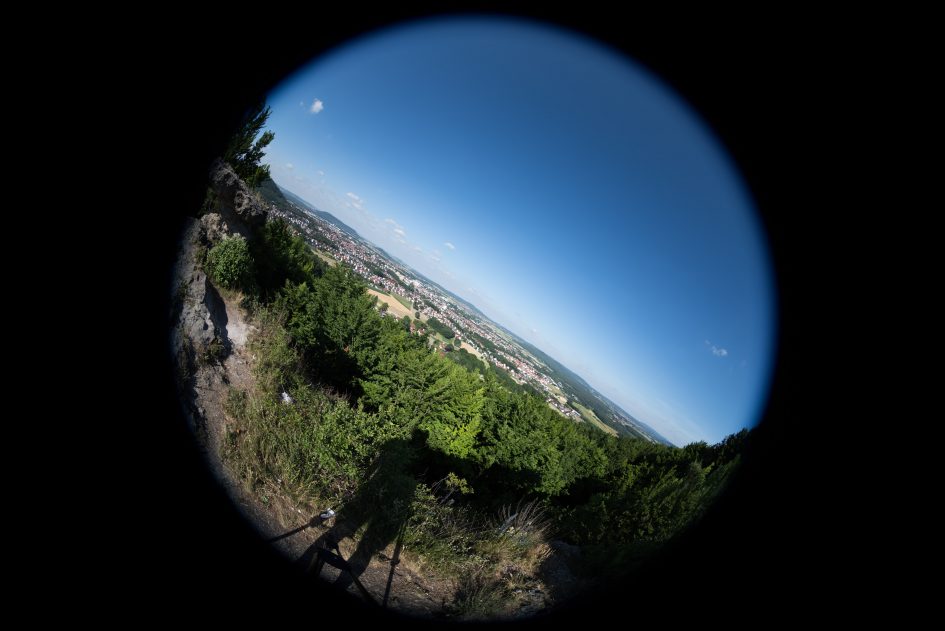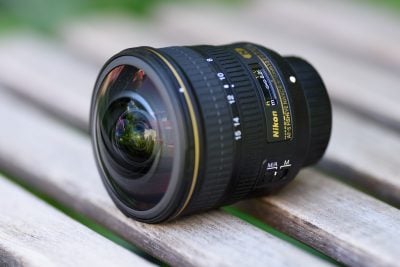Nikon 8-15mm f3.5-4.5 fisheye review
-
-
Written by Thomas
Quality
Longitudinal Chromatic Aberration and focus shift
The new Nikon fisheye has a focal ratios of around f4.0 so it should hardly be prone to longitudinal color aberrations (loCA, a.k.a. “axial color” or “bokeh CA”). These would show up as magenta coloration in the foreground and greenish hues in the background and are not easily corrected in post-processing. The following image shows that there’s nothing to worry about:

Above: Nikon 8-15/3.5-4.5E Longitudinal Chromatic Aberration (loCA). 100% crop, at 15mm, f4.5; left = foreground, right = background
In the course of this test I also could find no discernible focus shift.
Sharpness and contrast
Let’s have a look at the theoretical performance of the new lens (first pair of MTF-charts) at the wide and the long end first and compare it to the performance of its fixed focal brethren (second pair of MTF-charts):

Above: Nikon 8-15/3.5-4.5E MTF; left at 8mm, f3.5; right at 15mm, f4.5

Above: Nikon DX 10.5/2.8 MTF (left); Nikon 16/2.8D (right)
These charts show the lens-performance wide open without influence of diffraction. To read these charts you need to know that higher values are better and the closer the line-pairs are together the less astigmatism (= resolution depends on the orientation of the test-pattern) the lens has. The x-axis displays the distance from the optical axis (=center of the sensor) in mm. I’ll show you the real-life performance at about 20%, 60%, 90% off center on a D810 below – 100% being the outer edge of the image circle. It would be misleading to call these points “center”, “DX-corner”, and “FX-corner” like in my other lens reviews because of the variable size of the image circle that this zoom lens projects at different focal lengths.
From the charts, the new Nikon looks better than both of their fixed focal fisheyes. But keep in mind that both fixed focal lenses are shown at f2.8 which puts them at a disadvantage. The new zoom has quite some astigmatism especially at the long end. But let’s see how this theoretical performance translates into real life results in the sharpness test based on Siemens-stars.
What follows are near-center results (first column) followed by DX-corner results and FX-corner results on a D810. Processing was done in Lightroom 6.10 from RAW at Camera Standard settings with no extra tone, color, or saturation-adjustment. Noise-reduction is set to 0, sharpening to 35/0.5/36/10. White-balance was adjusted to a neutral white and I did some exposure compensation to make the brightness of all crops match. So you will not see light fall-off in the corners in this test. Removal of lateral CAs is ON but no lens profile was used. Focus was acquired separately for each crop at wide open aperture and not changed when stopping down.
The following are all 100% crops! The geometry of all crops gets more heavily distorted the further away from the optical axis they are taken. I also had to resort to some serious tilting of the camera for capturing the FX-corner at 15mm focal length. That’s the way with fisheye lenses.
First up is an overview of the wide-open performance at different focal lengths. You can jump to the detailed results at different apertures and comparisons with other lenses by clicking on the crops of the respective focal length below.
Nikon 8-15/3.5-4.5E; 100% crop from 20%, 60%, 90% off-center

Above: 8mm, f3.5

Above: 11mm, f4.0

Above: 15mm, f4.5
You can easily see that this lens is very sharp in the center across its zoom-range. The crops at 60% off-center are still very good at 8mm focal length but become a bit softer when the lens is zoomed in. 90% off-center the images suffer from some very visible astigmatism which becomes more pronounced towards the long end. When focusing these test-shots I decided to optimize focus for the sagittal lines oriented towards the image center. If you want to see all the details and comparisons, read on. Or fast-forward to the performance at long distances.
Performance at 8mm:
Nikon 8-15mm fisheye at 8mm on Nikon D810; 100% crop from 20%, 60%, 90% off-center

Above: 8mm, f3.5

Above: 8mm, f5.6

Above: 8mm, f8.0

Above: 8mm, f11

Above: 8mm, f16
Stopping down to f8 improves the border considerably but diffraction is already slightly softening the center.
Performance at 11mm:
Nikon 8-15mm fisheye at 11mm on Nikon D810; 100% crop from 20%, 60%, 90% off-center

Above: 11mm, f4.0

Above: 11mm, f5.6

Above: 11mm, f8.0

Above: 11mm, f11

Above: 11mm, f16
At 11mm focal length the center looks very good right from the start, while the crops 60% off-center profit a little from stopping down to f5.6. But the border of the image circle looks outright ugly and needs stopping down to f11 to resolve the vertical (meridional) lines.

Above: Nikon 8-15mm fisheye at 11mm, f4.0

Above: Nikon 10.5mm fisheye at 10.5mm, f4.0

Above: Tokina 10-17mm fisheye at 10mm, f4.0
In comparison with two other lenses the new Nikon fisheye zoom is the sharpest at 20% off-center but trails behind the Nikon 10.5/2.8G at 60% off-center and comes in last at 90% off-center where the Tokina makes quite a good appearance.
Performance at 15mm:
Nikon 8-15mm fisheye at 15mm on Nikon D810; 100% crop from 20%, 60%, 90% off-center

Above: 15mm, f4.5

Above: 15mm, f5.6

Above: 15mm, f8.0

Above: 15mm, f11

Above: 15mm, f16
As the image is now completely covering the full-frame sensor the crops from the outer 10% of the image circle effectively are the FX-corners. They again look dismal in this test although the readability of the text is a bit better than at 11mm focal length. But the inner 60% (covering the DX-frame) look good at the border and very good in the center.

Above: Nikon 8-15mm fisheye at 15mm, f4.5

Above: Nikon 16mm fisheye at 16mm, f4.5

Above: Tokina 10-17mm fisheye at 15mm, f4.5
At the long end both the new Nikon and the Nikon 16/2.8D are very sharp at 20% off-center. At 60% off-center all three lenses perform pretty similar with the new Nikon taking a slight lead while at 90% off-center the Tokina 10-17mm and the new Nikon vie for first place with the Nikon 16/2.8D trailing behind. Overall the new Nikon 8-15mm is the best of the three lenses at this focal length.
Performance at long distances
First up is an overview of the wide-open performance at different focal lengths. You can jump to the detailed results at different apertures and comparisons with other lenses by clicking on the crops of the respective focal length below.
Nikon 8-15/3.5-4.5E; 100% crop from 20%, 60%, 90% off-center

Above: 8mm, f3.5

Above: 11mm, f4.0

Above: 15mm, f4.5
In these long-distance shots the borders of the image-circle of Nikon’s new fisheye zoom look clearly better than in the previous tests. The lens shows now very good performance across the image at 8mm, a somewhat softer border at 11mm and a slight degradation from the edges of the APS-C/DX image-circle outwards at 15mm focal length. If you want to see all the details and comparisons, read on. Or use the tabs to fast-forward to the sample images.
Performance at 8mm:

Nikon 8-15mm fisheye shot with Nikon D810 at 8mm, f3.5, 64 ISO; also available at f4.0, f5.6, f8.0, f11, f16

Above: Nikon 8-15mm fisheye at 8mm, f3.5; 100% crop from 20%, 60%, 90% off-center

Above: Nikon 8-15mm fisheye at 8mm, f5.6; 100% crop from 20%, 60%, 90% off-center

Above: Nikon 8-15mm fisheye at 8mm, f8.0; 100% crop from 20%, 60%, 90% off-center

Above: Nikon 8-15mm fisheye at 8mm, f11; 100% crop from 20%, 60%, 90% off-center
Very good performance across the image with nothing to complain about – except a little vignetting at f3.5 which goes away at f5.6.
Performance at 11mm:

Nikon 8-15mm fisheye shot with Nikon D810 at 11mm, f4.0, 64 ISO; also available at f5.6, f8.0, f11, f16

Above: Nikon 8-15mm fisheye at 11mm, f4.0; 100% crop from 20%, 60%, 90% off-center

Above: Nikon 10.5mm fisheye at 10.5mm, f4.0; 100% crop from 20%, 60%, 90% off-center; also available at f2.8, f5.6, f8.0, f11, f16

Above: Tokina 10-17mm fisheye at 11mm, f4.0; 100% crop from 20%, 60%, 90% off-center; also available at 3.5, f5.6, f8.0, f11, f16
In comparison to the Nikon 10.5/2.8 (at f4.0) the new Nikon fisheye zoom lens shows the better resolution in each crop. The Tokina produces clearly softer results than both of the other lenses.

Above: Nikon 8-15mm fisheye at 11mm, f5.6; 100% crop from 20%, 60%, 90% off-center

Above: Nikon 8-15mm fisheye at 11mm, f8.0; 100% crop from 20%, 60%, 90% off-center

Above: Nikon 8-15mm fisheye at 11mm, f11; 100% crop from 20%, 60%, 90% off-center
Stopping down to f5.6 improves the light fall-off and increases the acuity of the image border.
Performance at 15mm:

Nikon 8-15mm fisheye shot with Nikon D810 at 15mm, f4.5, 64 ISO; also available at f5.6, f8.0, f11, f16

Above: Nikon 8-15mm fisheye at 15mm, f4.5; 100% crop from 20%, 60%, 90% off-center

Above: Nikon 16/2.8D fisheye at 16mm, f4.5; 100% crop from 20%, 60%, 90% off-center; also available at f2.8, f4.0, f5.6, f8.0, f11, f16

Above: Tokina 10-17mm fisheye at 15mm, f4.2; 100% crop from 20%, 60%, 90% off-center; also available at f5.6, f8.0, f11, f16
The Nikon 16/2.8D and the Tokina 10-17/3.5-4.5 (at 15mm) both produce images clearly inferior to the new Nikon fisheye zoom.

Above: Nikon 8-15mm fisheye at 15mm, f5.6; 100% crop from 20%, 60%, 90% off-center

Above: Nikon 8-15mm fisheye at 15mm, f8.0; 100% crop from 20%, 60%, 90% off-center

Above: Nikon 8-15mm fisheye at 15mm, f11; 100% crop from 20%, 60%, 90% off-center
Rendering of point-light sources at night-shots
Night-shots pose a different challenge for lenses as the contrast is even higher than under bright sun and point-light sources can reveal some weaknesses such as coma, haloing and color-aberrations that do not show up as prominently in other test-shots. The 100% crops below show the effect of coma of the new lens at 15mm focal length compared to the Nikon 16/2.8D:

Above: Nikon 8-15mm fisheye at 15mm, f4.5 (left), Nikon 16mm f2.8D fisheye at 16mm, f4.5 (right); 100% crop from 75% off-center
The new fisheye zoom has the advantage here over the old 16mm f2.8D: It has clearly less coma and shows almost no coloration around light sources. And at 8mm focal length the deformation of point-lights is even less.
Flare, ghosting, and sun-stars
A strong light-source shining directly into the lens could produce strange colorful ghost-images or reduce contrast considerably through flare and glare. And with fisheye lenses having an angle of view of 180 degrees it is often hard to avoid the sun shining into the lens. So I looked very closely and tried to provoke flare, glare, and ghosting.
The Nikon 8-15mm copes astonishingly well with strong light-sources in my opinion. It stays mostly clear of artifacts wide open. But if you want to produce sun-stars you need to stop the lens down to at least f8 and that is when you can provoke some flare, ghosting and rainbow halos (see images below).

Above: Strong light hitting the Nikon 8-15mm f3.5-4.5E at 8mm, f8.0 near the border (left) and 15mm, f8.0 near the center (right), crops
Outside the “darkroom” I also encountered some streaking artifacts like in this image or the image below:

Above: Strong light hitting the Nikon 8-15mm f3.5-4.5E at 12mm, f7.1, cropped; click image to access original at Flickr
But outside the diffraction spikes the lens produced deep blacks.
Next check out my sample images!
Check prices on the Nikon 8-15mm Fisheye at Amazon, B&H, Adorama, Wex. Alternatively get yourself a copy of my In Camera book or treat me to a coffee! Thanks!



